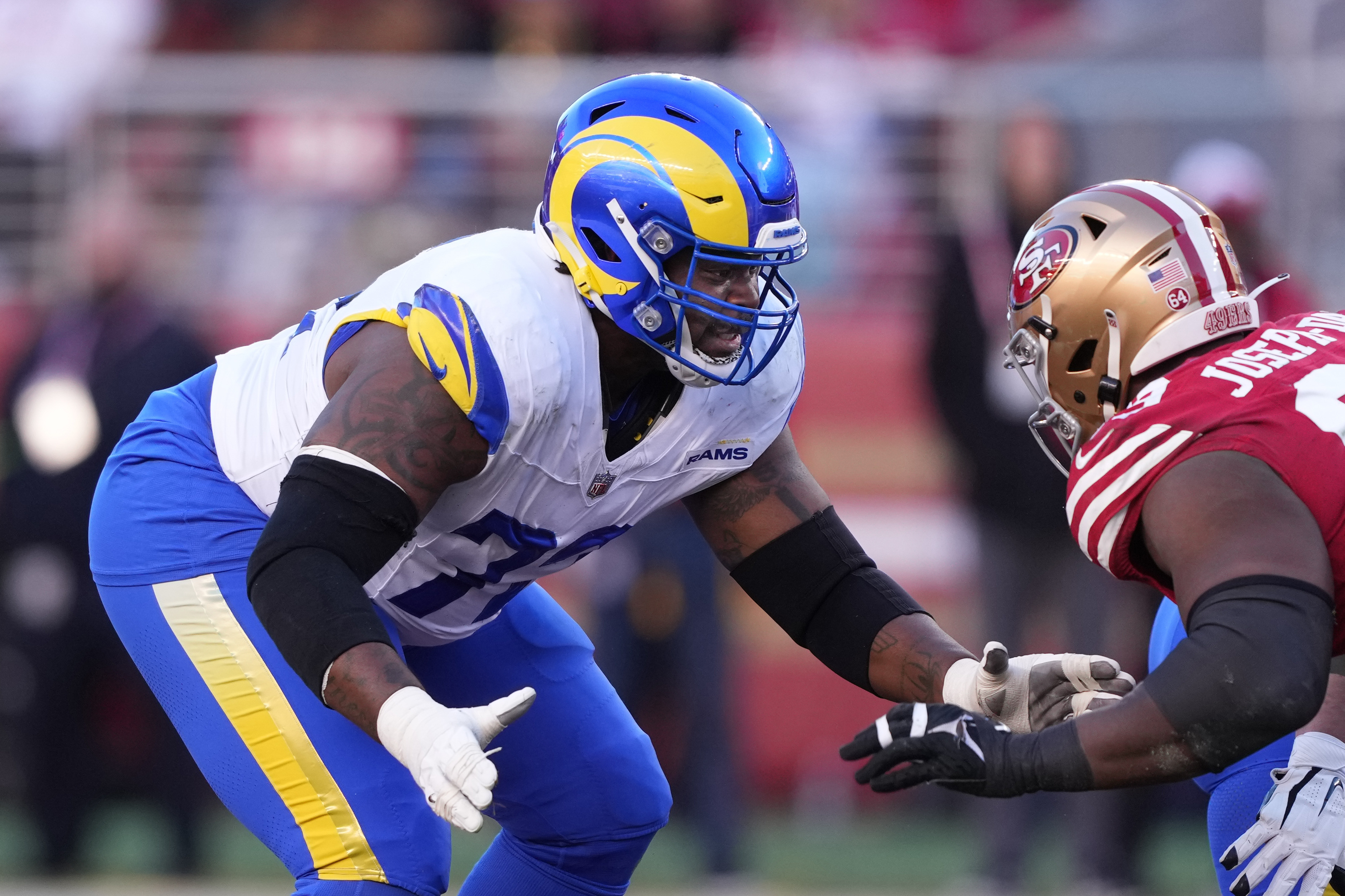John Schneider, Seahawks Continue to Skimp On Offensive Line

Sticking to previous trends of operation, the Seattle Seahawks have opted for a conservative approach in free agency, allowing the market to settle after other teams opened up the checkbook to bid on players when the legal tampering period officially opened on March 11.
With a few notable exceptions, including signing defensive tackle Dre'Mont Jones to a lucrative three-year contract last year, this has been Seahawks general manager John Schneider's preferred approach to free agency by bargain hunting with short-term deals. After sitting out the first two days without signing any players from outside the organization, he has signed seven players since, and five of those contracts were of the one-year variety, while the other two contracts are two-year pacts.
Demonstrating his characteristic frugalness once again, Schneider's desire to avoid handing out pricey multi-year contracts has been most evident in the trenches, where he has chronically been parsimonious. Despite entering the new league year with only one guard under contract and losing former starter Damien Lewis to Carolina, without counting center Nick Harris, who has started one game at guard in the NFL, Seattle didn't sign another player at the position until Monday, giving former Rams backup Tremayne Anchrum a one-year deal likely hovering around veteran minimum.
To put that signing in perspective, Anchrum hasn't even played 200 offensive snaps in four NFL seasons, leaving major question marks at both guard spots short and long-term.
What's behind Schneider's thrifty mindset when it comes to the guard position? Speaking with Dave Wyman and Bob Stelton of Seattle Sports 710 last Thursday, he opined that other teams tend to invest more in the position both in terms of money and draft capital than they should.
“Guys get overdrafted at that position and, in my opinion, they get overpaid," Schneider remarked.

With the market quickly drying up and few notable upgrade alternatives available to sign at this point, Schneider once again appears to be betting on coach Mike Macdonald and a new staff to develop players rather than paying for established talent, a strategy that has consistently yielded subpar results for more than a decade and puts an immense amount of pressure on the Seahawks to hit on a guard in next month's draft.
Since 2013, when Seattle had the highest-paid offensive line in the NFL in part due to quarterback Russell Wilson, linebacker Bobby Wagner, and a host of other young stars being on rookie contracts, the team hasn't finished higher than 11th in total spending up front. Per OverTheCap.com, the franchise has ranked 22nd or lower in total offensive line spending in nine of the previous 11 seasons, including currently being dead last in the NFL last year with just $13 million invested in the entire group.
In the case of 2023, the Seahawks had a pair of second-year starters at tackle in Charles Cross and Abraham Lucas as well as Lewis on rookie contracts. They also signed veteran Evan Brown and re-signed Phil Haynes for a total of $6 million and drafted Bradford in the fourth round, giving the offensive line limited experience and few dollars on veterans with a low tab of $16 million, which ranked 30th in the NFL for offensive line spending.
As a result, Seattle unsurprisingly finished 28th in Pro Football Focus' pass blocking grade and 25th in ESPN's Pass Block Win Rate. The team only proved to be marginally better in the run blocking department, finishing 15th and 17th in the two metrics respectively, ranking amongst the worst lines in the league overall.
Ravaged by injuries, including Lucas missing all but six games with a knee issue, the Seahawks started more than 10 different line combinations last season, which had a strong bearing on the unit's disappointing performance. Still, the unwillingness to invest more assets into protecting quarterback Geno Smith and run blocking for Ken Walker III and Zach Charbonnet can't be ignored, especially considering Cross, Lewis, and Brown started 12 games together as a trio.
What else cannot be ignored? Working in conjunction with former coach Pete Carroll, Schneider's stance on pinching pennies in the trenches has produced similarly lackluster results year in and year out, regardless of whether the group stays healthy or not.
Over the past 11 seasons, the Seahawks have never finished better than 18th in PFF's pass blocking grade and finished 25th or worse eight times. Making the success achieved by Marshawn Lynch and Chris Carson all the more impressive, they haven't been much better as run blockers, finishing in the top 15 in run blocking grade only three times compared to five finishes at 20th or worse.
Interestingly, even when the Seahawks spent a league-high $27 million on the offensive line in 2013, PFF graded the unit as 30th in pass blocking and 21st in run blocking, suggesting this isn't a mere case of getting what you pay for.

ESPN's advanced analytic metrics have graded Seattle a bit more favorably. In 2018, 2020, and 2022, the team finished in the top 10 in Pass Block Win Rate percentage. The team has never ranked better than 16th in run blocking in the past six seasons, however, further illustrating the struggles of the offensive line as a whole to sustain blocks in the ground game.
Choosing to go cheap has been an integral factor in the chronic difficulties protecting the quarterback and opening up running lanes, but in the case of the guard position specifically, lack of draft investment and development has been equally problematic.
In 14 prior drafts at the helm, Schneider as drafted only two guards in the first three rounds, as Lewis and John Moffitt were third-round selections. 2011 first-round pick James Carpenter eventually transitioned to guard after injuries and shaky performance, but the Seahawks initially drafted him with hopes of developing him into a quality right tackle coming out of Alabama.
With Lewis being the lone exception as a four-year starter, per Pro Football Reference, Seattle hasn't drafted a guard in the first four rounds that has netted an approximate value better than 18 since Schneider's first draft. In the later rounds, J.R. Sweezy proved to be the lone success story after moving from defensive tackle to guard and posting a respectable 35 approximate value in five seasons.
Dissecting more than a decade of data, Schneider's penchant for skimping along the offensive line hasn't negatively impacted the win/loss column, as Seattle has made the playoffs 10 times since his first season. The organization has also had top-10 scoring offenses eight times during that span, showing that subpar line play hasn't stopped the team from putting up points in most seasons.
Nonetheless, it's worth wondering how differently several of those seasons would have played out if the Seahawks diverted some of the money invested in other positions such as safety into the offensive line to pay for proven talent or used higher picks on guards and centers. The team hasn't advanced past the Divisional Round in a decade and poor blocking has undoubtedly contributed to that drought.
'Think the World Of Him': Sam Howell Eager to Learn From Geno
If there's a silver lining, this could be the perfect year to need a guard or two with a sensational incoming rookie class at the position. Headlined by Washington's Troy Fautanu, Oregon State's Taliese Fuaga, Oregon's Jackson Powers-Johnson, and Duke's Graham Barton, as many as five or six players with guard capabilities could go in the first 32 selections, giving the Seahawks options galore at No. 16 overall to promptly plug holes in the interior of the line.
But as evidenced by his comments and roster moves this offseason thus far, Schneider isn't changing his beliefs on the value of guards and based on previous track record, it won't be surprising if he bypasses picking a blue chip prospect such as Powers-Johnson in the first round. Instead, he will wait until a later round to address the situation, banking on a new coaching staff making the most of the talent provided to them from the bargain bin, including Bradford, Anchrum, and whoever comes in via the draft to compete.
Now in full control of personnel decisions after the departure of Carroll, if he doesn't select a guard early or picks one that can't immediately make an impact in the starting lineup, a neglected offensive line could once again hamper the Seahawks in Macdonald's first season on the sideline. By choosing to stick to his guns and not making adjustments to how he allocates resources to the line of scrimmage, Schneider may feel his cozy seat become a lot hotter in quick fashion.
